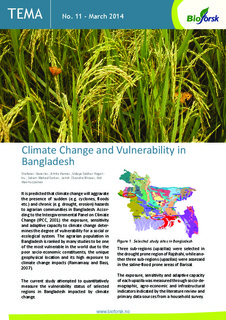Climate change and vulnerability in Bangladesh
| dc.contributor.author | Xenarios, Stefanos | |
| dc.contributor.author | Nemes, Attila | |
| dc.contributor.author | Nagothu, Sekhar | |
| dc.contributor.author | Sarker, G. | |
| dc.contributor.author | Biswas, J. | |
| dc.contributor.author | Maniruzzaman, Md | |
| dc.date.accessioned | 2017-06-01T08:58:45Z | |
| dc.date.available | 2017-06-01T08:58:45Z | |
| dc.date.created | 2014-03-28T10:05:29Z | |
| dc.date.issued | 2014 | |
| dc.identifier.isbn | 978-82-17-01255-9 | |
| dc.identifier.issn | 0809-8654 | |
| dc.identifier.uri | http://hdl.handle.net/11250/2444061 | |
| dc.description.abstract | It is predicted that climate change will aggravate the presence of sudden (e.g. cyclones, floods etc.) and chronic (e.g. drought, erosion) hazards to agrarian communities in Bangladesh. According to the Intergovernmental Panel on Climate Change (IPCC, 2001) the exposure, sensitivity and adaptive capacity to climate change determines the degree of vulnerability for a social or ecological system. The agrarian population in Bangladesh is ranked by many studies to be one of the most vulnerable in the world due to the poor socio-economic constituents, the unique geophysical location and its high exposure to climate change impacts (Ramamasy and Bass, 2007). The current study attempted to quantitatively measure the vulnerability status of selected regions in Bangladesh impacted by climate change. | nb_NO |
| dc.language.iso | eng | nb_NO |
| dc.publisher | Bioforsk | nb_NO |
| dc.relation.ispartof | Bioforsk TEMA | |
| dc.relation.ispartofseries | Bioforsk TEMA; | |
| dc.relation.uri | http://www.bioforsk.no/ikbViewer/Content/109068/Bioforsk%20TEMA%209%20(11).pdf | |
| dc.title | Climate change and vulnerability in Bangladesh | nb_NO |
| dc.type | Research report | nb_NO |
| dc.source.pagenumber | 4 | nb_NO |
| dc.source.volume | 9 | nb_NO |
| dc.source.issue | 11 | nb_NO |
| dc.identifier.cristin | 1125499 | |
| cristin.ispublished | true | |
| cristin.fulltext | original |
Files in this item
This item appears in the following Collection(s)
-
Bioforsk TEMA [234]
